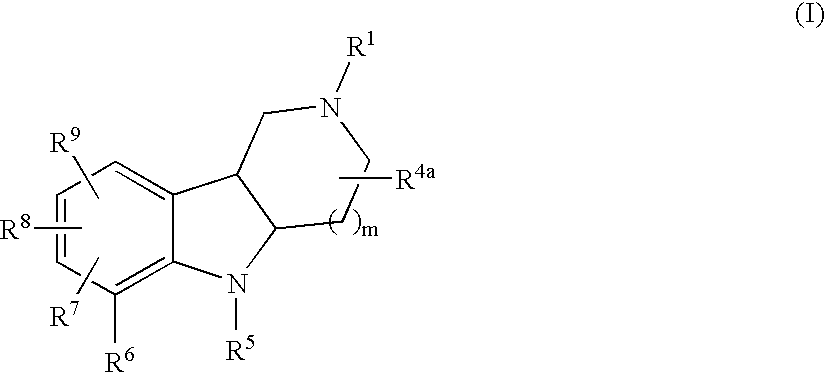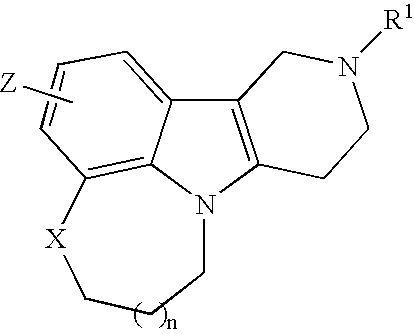Substituted tricyclic gamma-carbolines as serotonin receptor agonists and antagonists
a technology of serotonin receptor and substituted tricyclic gamma-carbolines, which is applied in the direction of biocide, drug composition, metabolic disorder, etc., can solve the problems of side effects of breakthrough treatments, but not without side effects
- Summary
- Abstract
- Description
- Claims
- Application Information
AI Technical Summary
Benefits of technology
Problems solved by technology
Method used
Image
Examples
example 1
cis-(4a,9b)-8-bromo-6-methylsulfanyl-2,3,4,4a,5,9b-hexahydro-1H-pyrido[4,3-b]indole
[0369]
[0370]Step A. 2-Methylsulfanyl-phenylamine (23.6 g, 169.5 mmol) was suspended in conc. HCl (200 mL) and trifluoroacetic acid (130 mL), and cooled to 0° C. in an ice bath. Sodium nitrite (14.0 g, 203.4 mmol) was dissolved in water (45 mL) and added dropwise to the suspension over 45 min. After the addition, the reaction was stirred at 0° C. for 1 h. In a separate flask, tin(II) chloride (76 g, 338.4 mmol) was dissolved in conc. HCl (100 mL) and added slowly over 15 min to the reaction mixture. The resultant suspension was warmed to rt and stirred for 48 h. The reaction was filtered, washed with iso-propyl alcohol (15 mL), and dried to give 1-(2-methylsulfanyl-phenyl)hydrazine hydrochloride (30 g, 93%). 1H NMR (CD3OD, 300 MHz) δ 7.44 (d, 1H, J=7.7 Hz), 7.32–7.26 (m, 1H), 7.08–7.00 (m, 2H), 2.39 (s, 3H) ppm.
[0371]Step B. 1-(2-Methylsulfanyl-phenyl)hydrazine hydrochloride (27 g, 141.9 mmol) and 4-pi...
example 2
cis-(4a,9b)-8-bromo-5-methyl-6-(methylsulfanyl)-2,3,4,4a,5,9b-hexahydro-1H-pyrido[4,3-b]indole
[0377]
[0378]Step A. To a methylene chloride (300 mL) solution of 6-methylsulfanyl-2,3,4,5-tetrahydro-1H-pyrido[4,3-b]indole hydrochloride (from Example 1, Step B) (18.03 g, 71 mmol) was added triethylamine (14.3 g, 142 mmol) in one portion and resulted solution was stirred at rt for 10 min. The reaction was cooled to 0° C. in an ice bath then di-tert-butyl dicarbonate (18.6 g, 85 mmol) was added, and then reaction was allowed to warm slowly to rt and stir for 14 h. Reaction mixture was poured into water (300 mL) and then layers separated. The aqueous layer was extracted with chloroform (3×100 mL) and the organics collected, washed with brine (150 mL), dried over MgSO4, and concentrated to dryness under reduced pressure. The resultant semi-solid was recrystalized from ethyl acetate to give tert-butyl 6-methylsulfanyl-1,3,4,5-tetrahydro-2H-pyrido[4,3-b]indole-2-carboxylate as sandy brown soli...
example 3
cis-(4a,9b)-6-methylsulfanyl-2,3,4,4a,5,9b-hexahydro-1H-pyrido[4,3-b]indol-8-amine
[0383]
[0384]Step A. Tert-butyl cis-(4a,9b)-8-bromo-6-methylsulfanyl-1,3,4,4a,5,9b-2H-pyrido[4,3-b]indole-2-carboxylate (from Example 1 step E)(950 mg, 2.37 mmol) and di-tert-butyl dicarbonate (1.29 g, 5.92 mmol) were mixed together neat and heated at 86° C. for 6.5 h under nitrogen. The resultant residue was purified by silica gel column eluting with 7.5% ethylacetate / hexanes to give di(tert-butyl)cis-(4a,9b)-8-bromo-6-methylsulfanyl-3,4,4a,9b-tetrahydro-1H-pyrido[4,3-b]indole-2,5-dicarboxylate as a foam (1.13 g, 95%). 1H NMR (DMSO d6, 300 MHz) δ 7.29 (s, 1H), 7.19 (s, 1H), 4.69–4.61 (m, 1H), 4.22–4.18 (m,1H), 3.71–3.62 (m,1H), 3.57–3.37 (m, 2H), 2.98–2.84 (m, 2H), 2.37 (s, 3H), 2.00–1.96 (m, 1H), 1.51 (s, 9H), 1.37 (s, 9H) ppm.
[0385]Step B. Di(tert-butyl)cis-(4a,9b)-8-bromo-6-methylsulfanyl-3,4,4a,9b-tetrahydro-1H-pyrido[4,3-b]indole-2,5-dicarboxylate (100 mg, 0.20 mmol), benzophenone imine (43 mg, 0....
PUM
| Property | Measurement | Unit |
|---|---|---|
| pH | aaaaa | aaaaa |
| pH | aaaaa | aaaaa |
| temperature | aaaaa | aaaaa |
Abstract
Description
Claims
Application Information
 Login to View More
Login to View More - R&D
- Intellectual Property
- Life Sciences
- Materials
- Tech Scout
- Unparalleled Data Quality
- Higher Quality Content
- 60% Fewer Hallucinations
Browse by: Latest US Patents, China's latest patents, Technical Efficacy Thesaurus, Application Domain, Technology Topic, Popular Technical Reports.
© 2025 PatSnap. All rights reserved.Legal|Privacy policy|Modern Slavery Act Transparency Statement|Sitemap|About US| Contact US: help@patsnap.com



